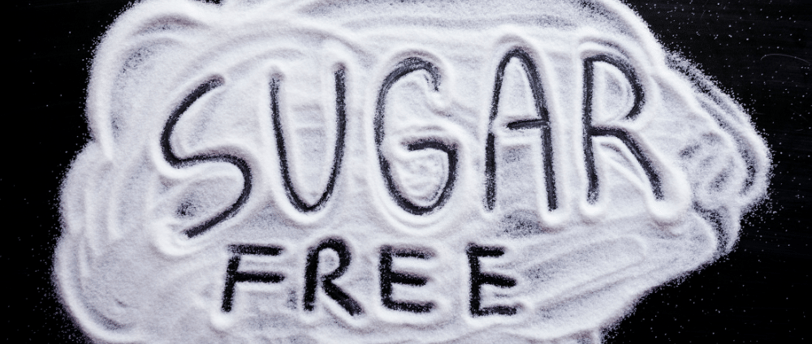Hidden Carbs in 'Sugar-Free' Foods That Spike Your Glucose
Discover the 7 hidden carb ingredients in 'sugar-free' foods that secretly spike your blood sugar. Learn how maltodextrin, tapioca starch, and other stealth glucose bombs sabotage diabetes management
6/15/20255 min read


Hidden Carbs in 'Sugar-Free' Foods That Spike Your Glucose
You're checking your blood sugar two hours after eating that "sugar-free" protein bar, and boom – 180 mg/dL.
What the hell happened?
You followed the rules. You read the label. It said "sugar-free" right there on the front. Zero grams of sugar listed in the nutrition facts.
But here's what the food industry doesn't want you to know: "sugar-free" doesn't mean "carb-free" or "blood sugar-friendly."
In fact, some of the worst blood sugar spikes I've seen in my clients come from foods marketed as "healthy" and "diabetic-friendly."
The $50 Billion Sugar-Free Lie
The global sugar-free food market is worth over $50 billion. These companies know exactly what they're doing when they slap "sugar-free" labels on products that still contain ingredients that spike your glucose.
They're betting you won't look beyond the marketing claims.
They're betting you won't understand the difference between "no added sugar" and "won't raise your blood sugar."
Most people lose that bet.
The 7 Hidden Carb Culprits Sabotaging Your Blood Sugar
Let me show you the ingredients that are legally "sugar-free" but will still send your glucose through the roof.
1. Maltodextrin: The Stealth Glucose Bomb
Maltodextrin has a glycemic index of 110. That's higher than pure glucose, which has a glycemic index of 100.
Read that again.
This "sugar-free" ingredient spikes your blood sugar faster than eating straight sugar.
You'll find maltodextrin in:
Sugar-free puddings and gelatin
Protein powders
Sugar-free salad dressings
Artificial sweetener packets (yes, even the "zero calorie" ones)
I had a client whose blood sugar jumped from 95 to 195 mg/dL after eating a "sugar-free" pudding cup. The first ingredient after water? Maltodextrin.
2. Tapioca Starch: The "Natural" Blood Sugar Wrecker
Food companies love tapioca starch because it sounds healthy and natural. It's not sugar, so they can claim "sugar-free."
But tapioca starch is nearly pure carbohydrate. It breaks down into glucose almost immediately in your digestive system.
One tablespoon of tapioca starch contains 8 grams of fast-acting carbs. That's enough to spike your blood sugar 40-50 points if you're insulin resistant.
3. Rice Syrup: The Whole Foods Impostor
Brown rice syrup sounds wholesome, doesn't it? It's often found in "natural" and "organic" sugar-free products.
Here's the truth: rice syrup is 65% glucose. It hits your bloodstream faster than table sugar.
A study in the Journal of Nutrition found that rice syrup raised blood glucose levels 20% higher than sucrose in people with diabetes.
4. Dextrose: Sugar's Evil Twin
Dextrose is literally glucose. It's chemically identical to the sugar in your blood.
But because it's not "sucrose" (table sugar), food companies can use it in "sugar-free" products.
When you eat dextrose, it goes straight into your bloodstream. No digestion required. It's like injecting glucose directly into your veins.
5. Corn Starch: The Thickening Agent That Thickens Your Blood Sugar
Corn starch is used to thicken sauces, soups, and "sugar-free" desserts. It's 100% carbohydrate.
When corn starch hits your stomach acid, it breaks down into glucose molecules within minutes.
One tablespoon of corn starch contains 7 grams of carbs. That might not sound like much, but it's enough to turn a "sugar-free" sauce into a blood sugar bomb.
6. Modified Food Starch: The Vague Villain
"Modified food starch" is a catch-all term that could mean anything. It's usually corn, wheat, or potato starch that's been chemically altered.
The problem? You never know which starch they're using or how it's been modified. Some modified starches digest even faster than regular starch.
7. Fruit Juice Concentrates: The "Natural" Deception
Apple juice concentrate, grape juice concentrate, and pear juice concentrate are all technically "sugar-free" because they're not added sugars – they're fruit extracts.
But concentrated fruit juice is essentially liquid fructose and glucose. It spikes your blood sugar just like any other sugar.
The Label Reading Strategy That Actually Works
Here's how to spot hidden carbs before they spike your glucose:
Ignore the front of the package completely. Marketing claims like "sugar-free," "no added sugar," and "diabetic-friendly" are designed to mislead you.
Look at total carbohydrates, not just sugars. The "Sugars" line under "Total Carbohydrates" only shows added sugars and naturally occurring sugars like lactose. It doesn't show starches that break down into glucose.
Check the ingredients list for the culprits I mentioned above. If you see maltodextrin, tapioca starch, rice syrup, dextrose, corn starch, modified food starch, or fruit juice concentrates in the first five ingredients, put it back on the shelf.
Calculate net carbs carefully. Subtract fiber from total carbohydrates, but don't subtract sugar alcohols completely. Many sugar alcohols still raise blood sugar.
The Blood Sugar Impact of Popular "Sugar-Free" Foods
Let me show you what these hidden carbs actually do to your glucose:
Sugar-free pudding cup: Despite being "sugar-free," a typical cup contains 15-20 grams of fast-acting carbs from maltodextrin and corn starch. Expected blood sugar spike: 60-80 points.
Protein bar (sugar-free): Often contains 10-15 grams of hidden carbs from tapioca starch and rice syrup. Expected spike: 40-60 points.
Sugar-free ketchup: Two tablespoons can contain 6-8 grams of carbs from corn starch and modified food starch. Expected spike: 20-30 points.
Sugar-free syrup: Despite having zero sugar, many contain maltodextrin as a thickener. Two tablespoons can spike your blood sugar 30-40 points.
The Artificial Sweetener Trap
Even artificial sweeteners aren't innocent. Many contain bulking agents that are pure carbohydrates.
Splenda packets: Each packet contains 0.9 grams of carbs from maltodextrin. Use 10 packets in your coffee, and you've consumed 9 grams of fast-acting carbs.
Equal packets: Contains dextrose as a bulking agent. Each packet has 0.9 grams of carbs.
Sweet'N Low: Contains dextrose and cream of tartar. Each packet has about 0.9 grams of carbs.
If you use multiple packets daily, these "zero calorie" sweeteners can contribute 10-20 grams of hidden carbs to your daily intake.
What to Eat Instead
Stop falling for the "sugar-free" marketing and focus on naturally low-carb whole foods:
For sweetness: Use liquid stevia, monk fruit extract, or erythritol. These don't contain bulking agents and won't spike your blood sugar.
For thickening: Use xanthan gum or guar gum instead of corn starch. A tiny amount goes a long way, and they're essentially zero-carb.
For snacks: Choose nuts, seeds, hard-boiled eggs, or cheese instead of processed "sugar-free" bars and cookies.
For condiments: Make your own or choose brands that use vinegar and spices instead of starches and syrups.
The 48-Hour Test
Here's how to know if a "sugar-free" food is truly blood sugar-friendly:
Day 1: Check your blood sugar before eating the food, then 1 hour and 2 hours after eating it.
Day 2: Eat the same food at the same time and recheck your blood sugar at the same intervals.
If your blood sugar rises more than 30 points either day, that food contains hidden carbs that your body can't handle.
The Bottom Line
The food industry has spent billions of dollars figuring out how to make processed foods taste good while technically meeting "sugar-free" labeling requirements.
They're not trying to help you manage your diabetes. They're trying to make money.
Your blood sugar doesn't care about marketing claims. It only responds to what you actually put in your mouth.
Stop trusting labels. Start trusting your glucose meter.
The only way to know if a food is truly blood sugar-friendly is to test it yourself. Everything else is just marketing.
Your Next Step
Pick one "sugar-free" food you eat regularly. Test your blood sugar before and after eating it for the next three days.
If it spikes your glucose more than 30 points, find a real alternative.
Your body will thank you for it.
And your path to diabetes remission just got a lot clearer.
